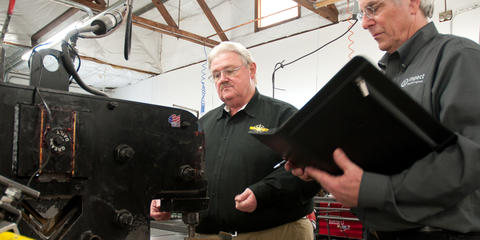Manufacturing Innovation Blog
Powered by the Manufacturing Extension Partnership

—Lewis M. Branscomb
In the first part of Reflections on the Manufacturing Extension Partnership at 25, the history of the growth of the MEP program from the original seven Manufacturing Technology Centers (MTCs) to today’s nationwide network was highlighted. In this second edition, we are focusing on the services the MEP system has provided to the manufacturers and how those services evolved to both meet the most challenging demands faced by manufacturers over the past 25 years and binding individual centers into a cohesive, strategically-focused network that forms a nationwide connection into the manufacturing community.
The Evolving Role of the MEP Program in the Global Economy
[rev_slider mepserv]
The early years of the MEP program were not just spent in funding and standing up new centers. Significant time and effort was spent to identify and respond to companies’ needs for manufacturing technology. To appreciate how the MEP services evolved, it is important to understand the enabling legislation of the program. Specifically 15 USC 278 states:
The objective of the Centers is to enhance productivity and technological performance in United States manufacturing through -
Transferring New Manufacturing Technology and Techniques. The transfer of manufacturing technology and techniques developed at the Institute to Centers and, through them, to manufacturing companies throughout the United States.
Capturing Participation From Industry, Universities, and State and Federal Government. The participation of individuals from industry, universities, State governments, other Federal agencies, and, when appropriate, the Institute in cooperative technology transfer activities.
Leading Efforts to Make New Technology and Processes. Efforts to make new manufacturing technology and processes usable by United States-based small- and medium-sized companies.
Disseminating Manufacturing Analysis. The active dissemination of scientific, engineering, technical, and management information about manufacturing to industrial firms, including small- and medium-sized manufacturing companies.
Utilizing Federal Laboratories. The utilization, when appropriate, of the expertise and capability that exists in Federal laboratories other than the Institute.
Bringing awareness to Skills Gap. Providing to community colleges information about the job skills needed in small- and medium-sized manufacturing businesses in the regions they serve.
Note the emphasis on the transfer of manufacturing technology and techniques, cooperative technology transfer and utilization of Federal laboratories other than NIST. While the original framers were thinking about the manufacturing programs in the NIST Manufacturing Engineering Laboratory, including the Automated Manufacturing Research Facility and Shop of the 90s as sources of technology and services, the reality in the field turned out to be very different.
The first seven MTCs learned very quickly from their manufacturing clients that the advanced technologies that NIST wanted to transfer weren’t what the manufacturers needed. In fact, what was needed was much more basic than what anyone thought – quality systems, plant layout and equipment automation – in essence, basic, proven technology. That led to a focus more on items 3 and 4 of the enabling legislation.
Over a relatively short period of time, the program settled on the incorporation of that proven, appropriate technology into a manufacturing business as the business model. A key feature of that business model included charging fees for the services provided. This was done, not so much to meet the cost requirements of the program, but rather to focus on value-added services. The measure of that value was that the manufacturers receiving the service were willing to pay something, perhaps not full cost, but something for it. Using former National Bureau of Standards (NBS, the precursor to NIST) Director Lewis Branscomb’s definition of innovation (quote above), we quickly got to the idea of applying technology inside the factory to ultimately make the business more competitive and hence, profitable.
From 1989 until 1996, the program’s principal emphasis was on establishing the national network – making sure there was a center within reach of all the nation’s manufacturers and linking those centers to one another so they could learn from and teach each other about how best to work with manufacturers. The initial services were focused on solving immediate and short-term problems – point solutions. The philosophy was an engineering one – “You have a problem. We can fix it.”
Initially, those point solutions expanded along the technological innovation track to include lean manufacturing principles (initially on the factory floor, then expanded to the front and back offices), hardware and software selection and integration, Y2K readiness, eBusiness, product development from the technical side including design and prototyping and other inside-the-company services to make them more efficient.
However, while point solutions are necessary to solve specific problems, they aren’t always sufficient to make more than a modest difference in a manufacturer’s future. In addition, while a point solution can be successfully implemented, if it’s done in the absence of more complete knowledge of the company’s situation (strategy, business state, etc.), you may not be working on the thing that’s most critical and the company goes out of business anyway. (The operation was a success but the patient died.)

A key feature of MEP’s work that continues today is that MEP Centers don’t just provide training and consulting on a given topic, and then leave the manufacturer on their own. They stay engaged in the implementation of the improvement opportunities as experience has shown that it is the implementation of enabling technologies, processes and knowledge in the business that ultimately makes the difference. Recognizing the current and future needs of manufacturing businesses are diverse and beyond productivity improvements inside the company, NIST MEP began to sponsor pilot efforts in finance, industrial (or business-to-business) marketing, relations with electric and gas utilities to explore ways to save energy, develop the future workforce, and reduce environmental waste. This was leading the direction of program becoming trusted advisors across the full manufacturing enterprise, but in 2004, for a number of reasons, the non-productivity improvement services were slowed and the focus turned almost exclusively to inside-the-plant services with clear costs and clear returns on the companies’ and Centers’ investments. In essence, the MEP system became the “lean experts” on developing production efficiencies. That model served the mission well for the next several years, but only addressed the “bottom line” side of the business.
More recently, as part of our journey, NIST MEP and the system began a process of developing a common national brand for the system and expanding the service offerings beyond lean to growth and technology acceleration. Through these early branding efforts, the MEP system developed a more common national identity, standards of service and ways of cooperating/ collaborating across Centers. The system also developed and started to apply a top-level client engagement model to lead to company transformation.

The service evolution continues today with the development and inclusion of technology scouting, technology-driven market intelligence, innovation services, lean product development, sustainability services and more. Innovation, the ability to bring new ideas, technologies, products and services to market profitably, is a key component to what we do going forward. The continued expansion and integration of services brings MEP closer to the goal of being THE management consultants and coaches to small- and medium-sized manufacturing businesses in the U.S.
—Frank Zappa


